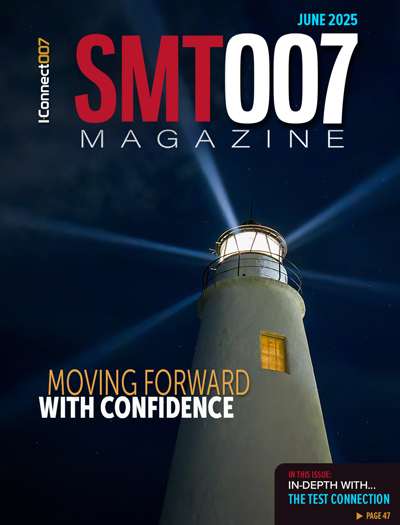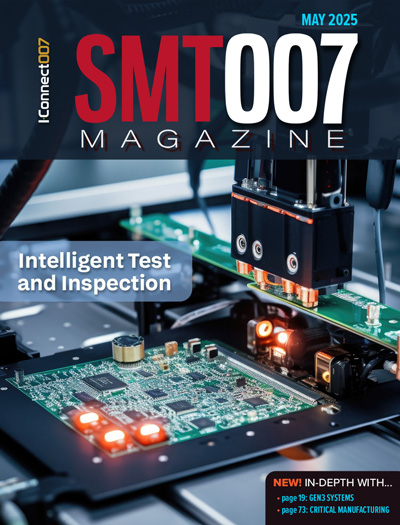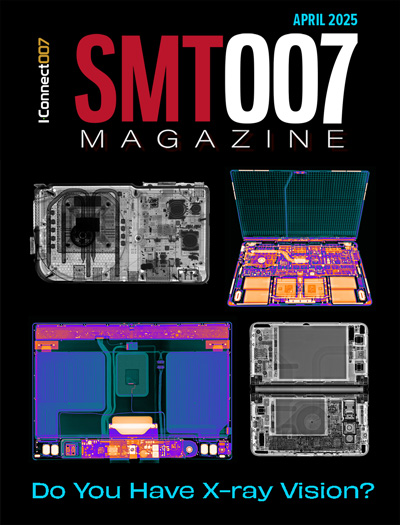-

- News
- Books
Featured Books
- smt007 Magazine
Latest Issues
Current Issue
Moving Forward With Confidence
In this issue, we focus on sales and quoting, workforce training, new IPC leadership in the U.S. and Canada, the effects of tariffs, CFX standards, and much more—all designed to provide perspective as you move through the cloud bank of today's shifting economic market.

Intelligent Test and Inspection
Are you ready to explore the cutting-edge advancements shaping the electronics manufacturing industry? The May 2025 issue of SMT007 Magazine is packed with insights, innovations, and expert perspectives that you won’t want to miss.

Do You Have X-ray Vision?
Has X-ray’s time finally come in electronics manufacturing? Join us in this issue of SMT007 Magazine, where we answer this question and others to bring more efficiency to your bottom line.
- Articles
- Columns
Search Console
- Links
- Media kit
||| MENU - smt007 Magazine
Mark Curtin on Large-Board Stencil Printing and Metal Squeegees
September 24, 2018 | Stephen Las Marias, I-Connect007Estimated reading time: 2 minutes
Transition Automation Inc. recently developed a large-area benchtop stencil printer targeted for high-mix low- or medium-volume production. Said to be one of the largest SMT printers available in the world, the PrinTEK AP-3224-V fine pitch SMT printer features a print area of 40" x 24" (101 cm by 61 cm) and uses lightweight composite materials in its design. According to Mark Curtin, president of Transition Automation, it is the first tool that enables users to do large-board production for under $75,000.
"It's nice to do development that's driven by the customer," said Curtin. "And I designed it to build more of them in the hopes that there will be other people that have difficult issues related to large-board production."
Curtin notes that there are just no available large-area stencil printers in the market. "You do a search, and you can’t find any machine. You can find large silk-screening machines, but that’s a different process. You may struggle with converting it to solder paste printing," he says.
The PrinTEK AP-3224-V is dedicated for stencil printing for solder paste. "Because it is an open system, and because it uses composite materials, you can actually order it, receive it in a crate, and be running it within an hour of receiving it. Whereas with most automated machine, you will have a crew and a rig coming in, and it is going to take several days to get it set up," Curtin says. "Considering a solution for a large board production, it is not a huge machine. Even the footprint of this is the same as the footprint of just a standard 18-by-18 automated printer. But it’s giving the print area double that, so that's pretty unique."
Metal vs Rubber Squeegee
One of the key factors contributing to defects in PCB assembly is the paste printing process. Curtin agrees. He also highlights the squeegee as among the key factors causing the defects.
"The one main thing that we always have been promoting is the idea that the squeegee, even though it is a very small, almost infinitesimal item, has a disproportional burden of providing the quality for the SMT line. If you would take one item (rubber squeegee) and reshape it in a minor way, it will result in a complete dysfunction for your SMT line,” explains Curtin. “So, the squeegee is one of the key things for quality and therefore it should also be built tough, built accurate, and it should have some features on it."
He notes that rubber was always used because with liquid ink printing, you need rubber to form a liquid gasket. But when the silkscreen printing was modified to stencil printing, where a stencil is used instead of a silkscreen, there is now a smooth surface on top, not a calendared screen.
"So now, you don’t need a rubber squeegee; you use a metal squeegee. The main thing that it does is shear the solder paste clean on the top of the stencil. It doesn't fit into the openings of the stencil, and because you are not dipping into the aperture, you are not wearing it out," says Curtin. "Because when a rubber goes over the aperture, it dips in, and it can shear off. Then you get lots of rubber microparts ending up in the solder paste. That will definitely contribute to voiding and gas problems in reflow."
Which is why, according to Curtin, metal squeegee is the way to go.
Suggested Items
Bridging the Knowledge Gap in Test: A Conversation with Bert Horner
06/11/2025 | Barry Matties, I-Connect007Bert Horner is a seasoned industry veteran and co-creator of The Test Connection, Inc. (TTCI), a test and inspection company spanning over 45 years. In this candid conversation, Bert reflects on the challenges our industry faces with the retirement of career professionals and the subsequent loss of critical tribal knowledge. As he unveils The Training Connection’s innovative training initiatives, Bert emphasizes the importance of evolving educational programs that align with industry needs, particularly in design for test (DFT), and sheds light on strategies being implemented to foster the next generation of engineers.
IPC Hall of Fame Spotlight Series: Highlighting Bob Neves
06/11/2025 | Dan Feinberg, I-Connect007Many IPC members who have contributed significantly to IPC and our industry have been awarded the IPC Raymond E. Pritchard Hall of Fame (HOF) Award. This Hall of Fame spotlight features industry veteran Bob Neves, who joined IPC in 1986 and was inducted into the IPC Hall of Fame in 2007.
Top Tech in Taiwan: IPC's Blueprint to Advance Smart Manufacturing
06/04/2025 | Sydney Xiao, IPCRenowned as a global hub of innovation and a cornerstone of the electronics industry, Taiwan is leading advancements in technology and manufacturing. A decade ago, IPC established an office in Taiwan, embedding itself deeply in this innovative ecosystem. Now with nearly 200 member companies in the region, IPC remains dedicated to driving standardization, education, and technological progress in Taiwan’s electronics manufacturing sector.
IPC Releases Latest Standards and Revisions Updates
06/05/2025 | IPCEach quarter, IPC releases a list of standards that are new or have been updated. To view a complete list of newly published standards and standards revisions, translations, proposed standards for ballot, final drafts for industry review, working drafts, and project approvals, visit ipc.org/status. These are the latest releases for Q1 2025.
IPC Launches New Wire Harness Design Course Led by Defense Industry Expert
06/03/2025 | I-Connect007 Editorial TeamIPC is expanding its educational offerings with a new online course designed to provide foundational knowledge in wire harness and cable design. The course, Introduction to Wire Harness Design I, is led by a seasoned mechanical engineer and subject matter expert in military cable systems working at FNSS Defense Systems in Turkey.


